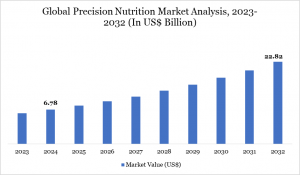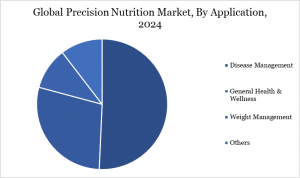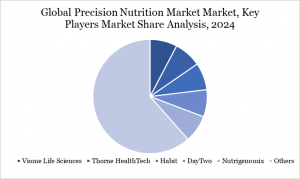Precision Nutrition Market Growth: USD 6.78 Bn in 2024 to USD 22.82 Bn by 2032 | Report Insights By DataM Intelligence
The Precision Nutrition Market was valued at USD 6.78 Billion in 2024 and is projected to reach USD 22.82 Billion by 2032, growing at a CAGR of 16.38%.
The Precision Nutrition Market Size was valued at USD 6.78 Billion in 2024 and is projected to grow significantly, reaching approximately USD 22.82 Billion by 2032, with a compound annual growth rate (CAGR) of 16.38% from 2025 to 2032.
To Download Sample Report: https://datamintelligence.com/download-sample/precision-nutrition-market
Latest Developments:
In September 2024, InsideTracker introduced Nutrition DeepDive, an innovative app designed to align nutrition with personalized health goals. This advanced tool links dietary intake covering food, drinks, and supplements to key health markers by integrating data from blood biomarkers, genetic analysis, and fitness tracking devices.
In November 2023, Viome Life Sciences completed the acquisition of digital wellness firm Naring Health to expand its personalized medicine offerings. This acquisition gives Viome access to valuable clinical and molecular data, reinforcing its commitment to developing tailored health solutions.
Regional Outlook: Global Momentum, Local Impact
North America
North America, particularly the United States, holds the lion’s share of the market. This dominance is driven by the region’s early adoption of cutting-edge healthcare technologies, coupled with the rising prevalence of chronic diseases like obesity and diabetes. Consumer demand for personalized supplements and nutrition tracking apps is growing fast, with many Americans willing to invest in diagnostics and subscription-based nutrition services.
Europe
Europe follows closely, especially countries like Germany, the UK, and the Netherlands. Government focus on preventive care and nutrition education is creating a favorable environment. Several startups are emerging across the continent, focusing on gut health, food sensitivity testing, and AI-driven dietary coaching.
Asia-Pacific
Asia-Pacific is quickly catching up. Countries like Japan, South Korea, China, and India are witnessing a growing awareness of gut health, nutrigenomics, and functional foods. Japan, in particular, is embracing precision nutrition as part of its aging population’s healthcare strategy, aiming to improve quality of life through dietary interventions.
Competitive Landscape: Who's Leading the Charge?
Viome Life Sciences
Thorne HealthTech
Habit
DayTwo
Nutrigenomix
InsideTracker
Care/of
Persona Nutrition
Xcode Life
23andMe
Market Segmentation:
By Technology: Metabolomics, Genomics, Transcriptomics, Proteomics
By Platform Type: Genetic Testing, Biomarker Analysis, Digital Health Platforms, Others
By Application: Disease Management, General Health & Wellness, Weight Management, Others
By End-user: Fitness and Wellness Centers, Hospitals and Clinics, Diagnostic Labs, Individuals, Others
Buy Now & Unlock 360° Market Intelligence: https://datamintelligence.com/buy-now-page?report=precision-nutrition-market
What’s Driving the Market?
Several trends are fueling market growth:
Rising chronic conditions: Diabetes, obesity, cardiovascular disease many are linked to poor nutrition. Precision nutrition offers targeted prevention.
Technological advancement: Affordable DNA sequencing and wearable tech make personalized health insights accessible.
Shifting consumer behavior: People want sustainable, functional, and convenient solutions tailored to them, not generic advice.
Holistic wellness movement: Mental and physical health are being seen as interconnected, with nutrition playing a central role.
Latest News of USA
In 2025, one of the major headlines from the U.S. precision nutrition market involves large-scale partnerships between healthcare providers and tech firms. A leading health insurance company has begun offering discounted premiums to users who adopt precision nutrition plans verified through connected health apps.
Additionally, multiple universities, including Stanford and Harvard, have launched new research labs focused exclusively on nutritional genomics and AI-driven health prediction. These initiatives aim to bring scientific rigor to the still-emerging sector of personalized nutrition and make interventions more clinically reliable.
One exciting development is the integration of continuous glucose monitoring (CGM) devices with custom meal planning apps. These innovations allow users to track their blood sugar responses in real-time and adjust their diet accordingly. U.S. consumers have responded with enthusiasm, especially those managing prediabetes or seeking weight loss through metabolic awareness.
Latest News of Japan
Japan is taking a culturally unique approach to precision nutrition by blending traditional food science with modern genomics. In 2025, Japanese researchers unveiled a pilot program in Tokyo that provides DNA-based meal plans for elderly citizens. The project is backed by the Ministry of Health and aims to combat age-related diseases through personalized food recommendations.
In another noteworthy development, a well-known Japanese convenience store chain has started offering “smart bento boxes” designed based on popular nutrigenomic profiles. These ready-to-eat meals cater to individuals with specific nutritional needs, such as high omega-3, anti-inflammatory properties, or low-carb for glucose control.
Japan is actively investing in digital health education to facilitate and strengthen this transformation. Universities are offering courses in nutrigenetics and precision health, training a new generation of dietitians and researchers ready to lead the way in Asia.
Conclusion
The Precision Nutrition Market is more than a trend it’s a shift in how we understand and manage health. With strong growth potential, cross-industry collaboration, and increasing public interest, this sector is set to redefine wellness on an individual level. From DNA kits on your doorstep to AI-powered meal suggestions, the age of personalized nutrition is here.
As innovation continues across the U.S., Japan, and beyond, precision nutrition will likely become a cornerstone of both clinical practice and everyday living, offering not just better health but better lives.
Here are the Experts Researched Related Reports By DataM intelligence
Sports Nutrition Market Size 2025-2032
Personalized Nutrition Market Size Till 2031
Purchase Industry Subscription Today – Make Smarter Decisions Tomorrow: https://www.datamintelligence.com/reports-subscription
Sai Kiran
DataM Intelligence 4Market Research
+1 877-441-4866
Sai.k@datamintelligence.com
Visit us on social media:
LinkedIn
X
Legal Disclaimer:
EIN Presswire provides this news content "as is" without warranty of any kind. We do not accept any responsibility or liability for the accuracy, content, images, videos, licenses, completeness, legality, or reliability of the information contained in this article. If you have any complaints or copyright issues related to this article, kindly contact the author above.
Delayed Symptoms: How Hidden Injuries Can Impact Personal Injury Cases
True Roots Medical Spa Introduces FDA-Cleared Laser Treatment for Men's Hair Restoration in Los Angeles
USC Alumnus Launches JobSnap to Help Students Take Control of Their Financial Future
Więcej ważnych informacji
 Jedynka Newserii
Jedynka Newserii

 Jedynka Newserii
Jedynka Newserii

Finanse

K. Gawkowski: Polska w cyfrowej transformacji gospodarki awansowała do pierwszej ligi w Europie. 2,8 mld zł z KPO jeszcze ten proces przyspieszy
Uruchomiony na początku lipca przez Ministerstwo Cyfryzacji i BGK program „KPO: Pożyczka na cyfryzację” cieszy się dużym zainteresowaniem. Samorządy, uczelnie oraz firmy mogą wnioskować o wsparcie finansowe dla inwestycji w transformację cyfrową, m.in. modernizację infrastruktury czy cyberbezpieczeństwo. W sumie na ten cel trafi 2,8 mld zł (650 mln euro). Ze względu na krótki czas naboru obie instytucje organizują w poszczególnych województwach warsztaty dla wnioskodawców, które mają rozwiać ich wątpliwości przy przygotowywaniu wniosków.
Prawo
Koszty certyfikacji wyrobów medycznych sięgają milionów euro. Pacjenci mogą stracić dostęp do wyrobów ratujących życie

Od 2027 roku wszystkie firmy produkujące wyroby medyczne w Unii Europejskiej będą musiały posiadać certyfikat zgodności z rozporządzeniem MDR (Medical Devices Regulation). Nowe przepisy wprowadzają dużo ostrzejsze wymagania w zakresie dokumentacji, badań klinicznych oraz procedur certyfikacyjnych. Branża ostrzega, że część małych i średnich producentów nie zdąży się dostosować. Problemem jest także wysoki koszt i długi czas uzyskiwania certyfikatów. W konsekwencji z rynku mogą zniknąć urządzenia ratujące życie.
Infrastruktura
Nowe przepisy o ochronie ludności cywilnej wprowadzają obowiązkowe elastyczne zbiorniki na wodę. Mają one służyć w razie suszy, pożarów czy wybuchu wojny

Samorządy będą musiały posiadać m.in. elastyczne zbiorniki na wodę pitną i przenośne magazyny wody przeciwpożarowej. To element odpowiedniego przygotowania zasobów na wypadek sytuacji kryzysowych, kataklizmów czy wybuchu konfliktu, wprowadzony nowymi przepisami o ochronie ludności. Eksperci podkreślają, że tego typu rozwiązania to innowacyjne produkty, które nie tylko ułatwiają logistykę w sytuacjach kryzysowych, ale także mogą znacząco skrócić czas reakcji służb ratunkowych.
Partner serwisu
Szkolenia

Akademia Newserii
Akademia Newserii to projekt, w ramach którego najlepsi polscy dziennikarze biznesowi, giełdowi oraz lifestylowi, a także szkoleniowcy z wieloletnim doświadczeniem dzielą się swoją wiedzą nt. pracy z mediami.










.gif)

 |
| |
| |
|